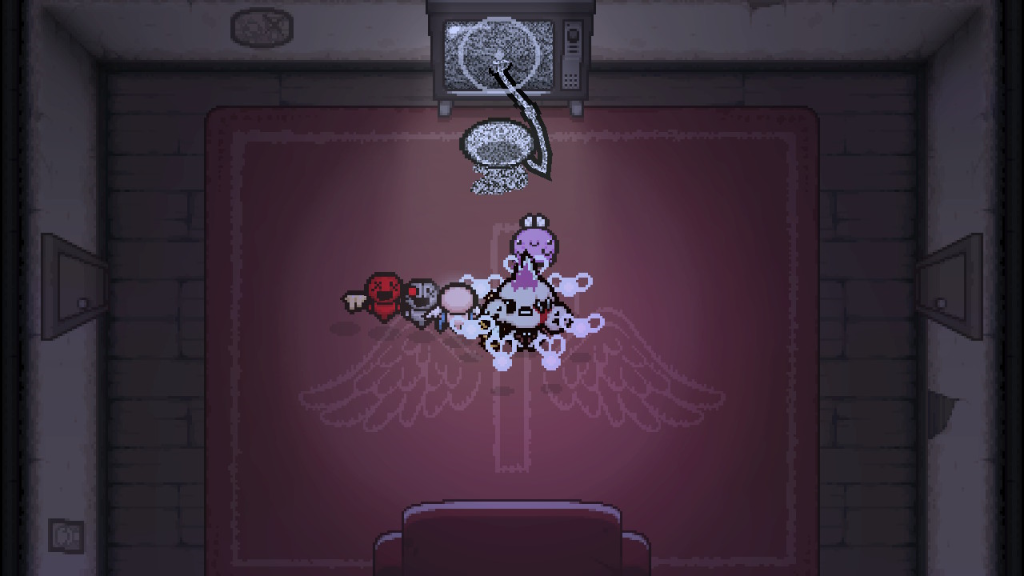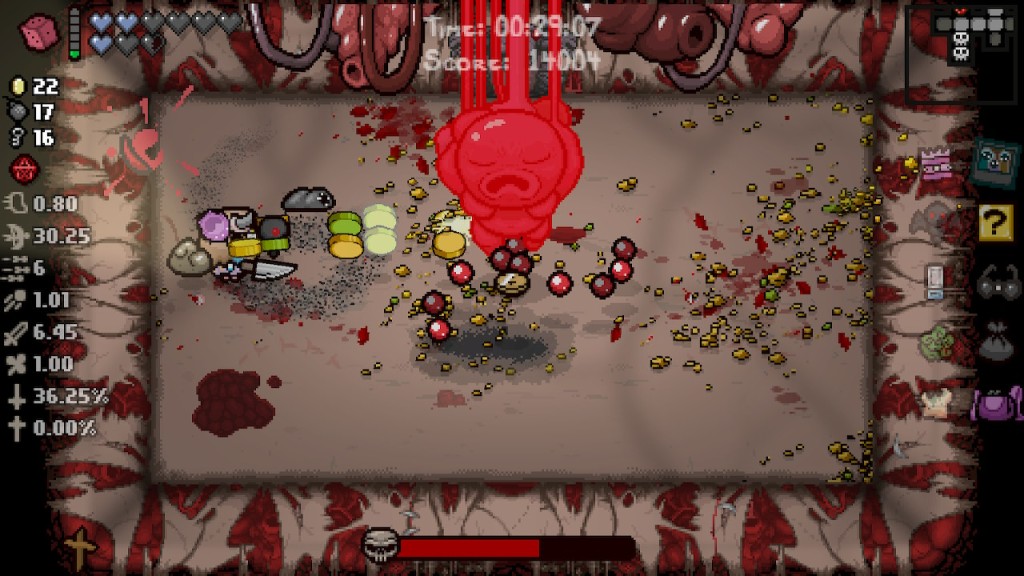
The Binding of Isaac is my favorite game and I’ve been playing way too much of it lately. Since the final expansion, Repentance, released on consoles last week, the game has its hooks firmly in me again after months of not really touching it. There are a few games I experience this waxing and waning of interest with: Stardew Valley, the Monster Hunter and Pokémon series, Darkest Dungeon—all games I will have a feverish urge to play all of suddenly, games I will obsessively play for a few weeks, and not have to desire to touch again for months until the cycle repeats. I call these types of games “Forever Games” and Isaac is my ride-or-die forever game.
No game is meant to last forever, though, so how can a game be considered a forever game? I define this type of game not as a game that will take up 100% of your free time and be the only thing you play for the rest of your life, but more so a game you can pick up, play, out down, and return to at any time and still enjoy as much as always. I often think about what would happen if I ever had to get rid of my game collection, to pare it down to just a few titles and have only them to play going forward. Although I have lots of games—probably too many games—on my shelf and digitally to play, I feel like I could easily just choose three to five games in my collection to last me forever. And I honestly think that anyone who plays video games could do the same. They may be massive strategy games, MOBAs or MMOs, multiplayer shooters, or giant open world games. These games, the ones that someone could look at and say “I could be happy just playing this for the rest of my life if I had to,” these are forever games to me.
There is another term that is similar to mine of the forever game: the desert island game. You might be asking what the difference between a forever game and desert island game is and the answer is delicate. I don’t much like the term desert island game. It strikes me as more of a thought experiment or game you discuss with your friends. Choosing a game that you would want to be stranded on an island with as opposed to a game you could see yourself enjoying playing at any time is a subtle but important difference. I might choose a game like Skyrim, a game I would want to force myself to make the time to play, for a desert island game; I might choose a big game that would take forever to 100% like Super Mario Odyssey or Breath of the Wild; or I might choose some sort of fighting or strategy game so I have the time to dig deep and learn it inside out. Choosing a game with the expectation of forced isolation is less personal than choosing a game you have already played and know for certain you would be happy playing for the rest of your life. And that brings me back to The Binding of Isaac.

I can’t recall how I first learned of Isaac. It might have been from an old Super Beard Bros video or just a random top 10 YouTube video. I do remember the hours and hours I’ve poured into the game since first playing it in 2015. I put 200-300 hours in on my 3DS, 200+ hours so far on my Switch, and countless hours (I would estimate at least another 200) on my PS4. Isaac has been with me for half a decade and has shaped the gamer I am today; it helped me through some of my worst bouts of depression; and helped me discover my favorite YouTuber: Northernlion—which is obvious if you are familiar with the man’s content. But this is all to say that I love Isaac; obviously, it is my forever game. Now let’s answer why that is.
Isaac is a roguelike, meaning each time you boot it up the rooms, items, bosses, everything is randomly generated. Death ends a run and you start completely fresh when dropping back into the basement for a new one. This is all standard roguelike stuff, but what sets Isaac apart in my mind are the synergies. With hundreds of items, all combining and interacting with each other in strange, powerful, or run-ruining ways, each run feels more different in Isaac than any other roguelike I’ve played. More entertaining too. Besides discovering new combinations or building different archetypes of runs, the visual spectacle of wacky synergies is always a blast to watch. Isaac is an endlessly replayable game. Not just due to the randomly generated runs and seemingly infinite ways the items interact with each other, but because it is just absolutely massive.
There is just a shit ton of content in the Binding of Isaac. 34 different characters to play as, different routes to take and end bosses to fight, 45 special challenge runs to beat, and over 600 secrets to unlock that give you new items, trinkets, and consumables to play with in the game. If you only unlocked one new thing in The Binding of Isaac a day, it would take at least a few years to get everything. I’ve been playing the game off and on for over five years and I still have never gotten a 100% completed save file—although, this is mainly due to moving what console I primarily play it on. There are hundreds of hours to juice out of Isaac just to get a 100% save file and after that, you can just keep playing it since every run is different and fun. And the best part about this is that it feels like a complete game. There are no pay-to-win mechanics, no option to just purchase a deluxe edition with everything unlocked, no road map or any of the live service bullshit that seems to fill half of the AAA games releasing now. While those types of games feel soulless, cynical, and greedy, Isaac still feels nurtured, personal, and true to its designer, Edmund McMillen.
Even a game as story light as Isaac needs context for the world it brings the player into. It needs themes for the players to reflect on. The Binding of Isaac deals in themes of Catholic guilt, dysfunctional families, religion zealotism, and child abuse. McMillen uses the game to explore these themes as they affect his upbringing, his current life, and the world at large; and they very thematically resonate to me. Through playing Isaac, I found myself looking back on my own Catholic upbringing and family life as a kid, not only the bad, but also the good. It helped me accept how those things molded me into the person I am today. It helped me see religion as a whole in a less black-and-white way than I used to; helped me see the community some people find in their religion and the good it can do.
This connection with the themes, this interest in Catholic myths and demons the game fostered in me, is a huge reason why I continue coming back to Isaac again and again and again. Add to that, the replayable nature of the game and mountain of things to unlock, characters to play as, and synergies to learn, and the game never gets stale. It is the game I boot up when I just need to kill an hour or two. It is the game I turn on when I have no interest or am too depressed to play any of the other games on my shelf. It is the game I can also rely on to destress or calm me down when I’m feeling too anxious. With the release of Repentance on consoles, I am determined now to finally buckle down and 100% the game. It might take forever to do, but that’s fine since The Binding of Isaac is, now and always will be, my forever game.













